
Alfred Edward Robie Farmer Cheatle (Born Dosthill, Warwickshire 15 January 1871 - 29 November 1941 Woodleigh Nursing Home, Wylde Green) [1] was an architect [2] based in Birmingham.

Alfred Edward Robie Farmer Cheatle (Born Dosthill, Warwickshire 15 January 1871 - 29 November 1941 Woodleigh Nursing Home, Wylde Green) [1] was an architect [2] based in Birmingham.
Cheatle was the son of Thomas Farmer Cheatle (1840-1918) and Mary Sarsons (b. 1838). He entered into a partnership around 1891 with Thomas Walter Francis Newton as his partner, and until the death of Newton in 1903, they traded as Newton and Cheatle. Cheatle married Rhoda Beatrice Barker (1872-1956) on 22 May 1901 in Kingsbury, Warwickshire. They had two children, Godfrey Barker and Kathleen Thelma.
Cheatle was for many years chairman of Tamworth Rural District Council. In later life, he lived in Chalford, Four Oaks, Birmingham. He left an estate of £16,329 9s 10d (equivalent to £1,021,500in 2023). [3]
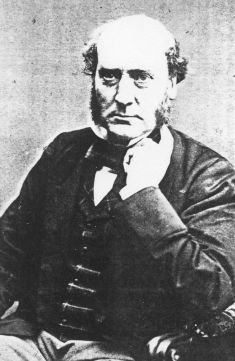
Sir George Gilbert Scott, largely known as Sir Gilbert Scott, was a prolific English Gothic Revival architect, chiefly associated with the design, building and renovation of churches and cathedrals, although he started his career as a leading designer of workhouses. Over 800 buildings were designed or altered by him.
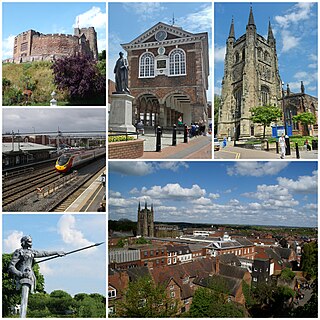
Tamworth is a market town and borough in Staffordshire, England, 14 miles (23 km) north-east of Birmingham. The town borders North Warwickshire to the east and south, Lichfield to the north, south-west and west. The town takes its name from the River Tame, which flows through it. The population of Tamworth borough (2022) was 79,639. The wider urban area had a population of 81,964.
Four Oaks is an affluent residential area in Sutton Coldfield, West Midlands, lying along the north and east borders of Sutton Park. Four Oaks is situated approximately 7+1⁄2 miles (12.1 km) north of Birmingham City Centre, and is bordered by Sutton Park, Streetly, Mere Green, Little Aston, Roughley and Aldridge. Four Oaks has a population of 21,690 as of 2004, and is part of the Sutton Four Oaks electoral ward.

Julius Alfred Chatwin FRIBA, ARBS, FSAScot was a British architect. He was involved with the building and modification of many churches in Birmingham, and practised both Neo-Gothic and Neo-Classical styles. His designs always included all of the carvings and internal fittings.

Herbert Tudor Buckland was a British architect, best known for his seminal Arts and Crafts houses, the Elan Valley model village, educational buildings such as the campus of the Royal Hospital School in Suffolk and St Hugh's College in Oxford.

William Henry Bidlake MA, FRIBA was a British architect, a leading figure of the Arts and Crafts movement in Birmingham and Director of the School of Architecture at Birmingham School of Art from 1919 until 1924.
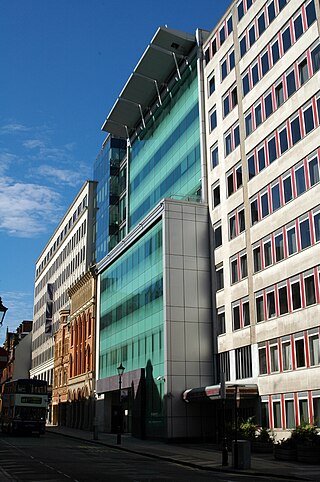
Edmund Street is a street located in Birmingham, England.

Holland William Hobbiss, was an English architect in the Birmingham area. He traded under the names Holland W. Hobbiss and Partners and Holland W. Hobbiss and M. A. H. Hobbiss.

Charles Edward Bateman FRIBA was an English architect, known for his Arts and Crafts and Queen Anne-style houses and commercial buildings in the Birmingham area and for his sensitive vernacular restoration and extension work in the Cotswolds.
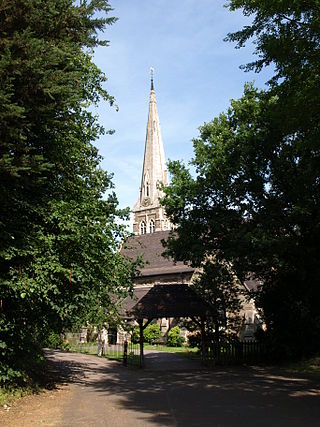
St. Mary's Church, Selly Oak is a Church of England parish church in Selly Oak, Birmingham, England.

James & Lister Lea was an architectural and property consultancy firm active in England between 1846 and 2001.

Seckington is a village and civil parish in North Warwickshire, about 4 miles (6 km) northeast of Tamworth. The B5493 road between Tamworth and Appleby Magna runs through the parish, passing about 100 yards (91 m) north of the village. Seckington shares a parish council with Newton Regis and No Man's Heath. Forming part of the border with Staffordshire, it is the second most northerly settlement in Warwickshire, with only No Man's Heath situated further north, and is only 3.5 miles due south of the Derbyshire border.

St Benedict's Church, Bordesley is a Church of England parish church in Hob Moor Road, Bordesley, West Midlands, England, about 2+1⁄2 miles (4 km) east of Birmingham city centre. It is an early 20th-century church in Byzantine Revival style and is Grade II listed.

St Alban the Martyr, Birmingham is a Grade II* listed Church of England parish church in the Anglican Diocese of Birmingham. It is dedicated to Saint Alban, the first British Christian martyr.
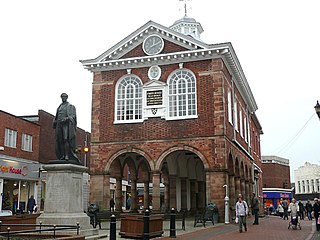
Tamworth Borough Council is the local authority for the borough of Tamworth in the county of Staffordshire, England. The council consists of 30 councillors, three for each of the 10 wards in the town. It is currently under no overall control, led by Labour councillor Carol Dean, since May 2024. The borough council is based at Marmion House.

Frank Barlow Osborn FRIBA was an English architect based in Birmingham.

Thomas Walter Francis Newton was an architect based in Birmingham.
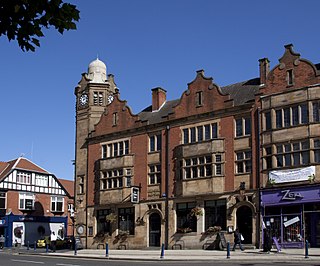
The Fighting Cocks is a Grade II listed public house in Moseley, Birmingham, England.
Tamworth is a market town and borough in Staffordshire, England. It contains 138 listed buildings that are recorded in the National Heritage List for England. Of these, three are listed at Grade I, the highest of the three grades, five are at Grade II*, the middle grade, and the others are at Grade II, the lowest grade. The town includes its central area and the districts of Amington, Bolehall, Dosthill, Fazeley, Glascote, and Wilnecote. The most important buildings in the town are the Church of St Editha, and Tamworth Castle and its causeway walls, all of which are listed at Grade I. Most of the listed buildings are houses and associated structures, shops and offices, many of which originated as houses. The Coventry Canal passes through the town and makes a junction with the termination of the Birmingham and Fazeley Canal. The listed buildings associated with the canals are bridges, an aqueduct, and a milepost. The other listed buildings include churches and items in churchyards, public houses, bridges over the River Tame, other structures associated with the castle, former schools, parts of medieval walls, a farmhouse, a barn, a hotel, a former workhouse, public buildings, banks, a milestone, a railway viaduct, a bowling clubhouse, statues, one of Sir Robert Peel and the other of Ethelfleda, and a war memorial.

The Moseley Conservation Area is in Moseley, Birmingham.